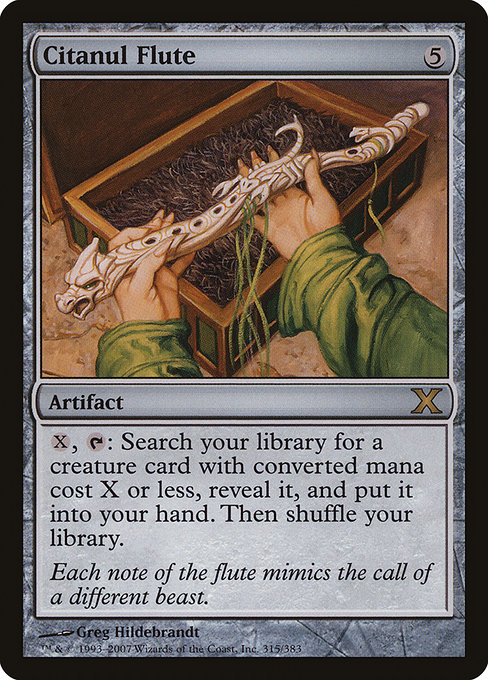
Image courtesy of Scryfall.com
Fun as a Design Principle: Citanul Flute and the Psychology of Choice
In Magic: The Gathering, the most enduring fun often hides in the small, bite-sized decisions that recur every game. Citanul Flute embodies that philosophy in a colorless, shimmering way. This 2007 piece from Tenth Edition is an artifact with a deceptively simple line of text: X, {T}: Search your library for a creature card with mana value X or less, reveal it, put it into your hand, then shuffle. The costs are high—{5} to cast—but the payoff is a flexible ladder of possibilities. You decide how large X should be, judging risk, tempo, and the creature mana curve of your deck. The result isn’t just a tutor; it’s a study in how players savor agency within a fixed rule set 🧙♂️🔥.
That sense of agency is at the heart of the philosophy of “fun” in game mechanics. With Citanul Flute, you’re not just drawing a card; you’re designing a moment. Do you fetch a resilient blocker early to stabilize a fragile board, or a game-changing fatty to slam through on a crucial turn? The X parameter makes this decision dynamic, not static. If your deck leans on low-cost utility creatures, you might set X small to search for the perfect blocker or synergy piece. If your late-game plan centers on a massive threat, you could push X higher to fish for a finisher. The trade-off—spent mana now for knowledge about future draws—taps into a classic tension in MTG design: maximize control while preserving surprise 😎.
“Choice is the engine of play; the more meaningful choices you surface, the more the game feels personal.”
From a lore and flavor perspective, Citanul Flute’s flavor text — “Each note of the flute mimics the call of a different beast.” — reinforces the idea that magic is a conversation with nature. The flute’s notes mirror the beastly variety you might conjure from your library: a chitinous defender, a swift predator, or a towering behemoth. The artifact’s colorless identity makes it a friendly guest at any table, a reminder that fun isn’t bound to a particular color wheel; it’s about what you can discover with a clever setup 🧭.
Designers have long debated the best way to capture “fun” in a card’s mechanics: is it complexity, speed, or sheer volatility? Citanul Flute leans toward measured complexity wrapped in tidy simplicity. It offers a tactile sense of discovery—like turning the page of a choose-your-own-adventure—without overload. The ability is also notably compatible with a wide swath of strategies, which makes it a nostalgic centerpiece for players who love the early-2000s core-set era while still feeling modern enough for EDH decks. Its rarity (rare) and standalone identity underscore a precise design goal: empower thoughtful, personalized play rather than forcing a single, one-size-fits-all line of play 🔬.
If you’re a fan of the tactile ritual of deck-building, Citanul Flute rewards it. You’re not just planning one turn; you’re drafting your future draws mid-game, scouting the possibilities you’ll reveal on the next X turns. This is the essence of a “fun engine”—a card that invites multiple lines of inquiry, invites collaboration with your deck’s creature suite, and rewards careful curation. And because it’s legal in formats like Commander, the card becomes a collective memory point in many tables—a shared moment of “remember when I fetched that Beast of a creature at X and absolutely swung the game?” 🧙♂️🎯
From a gameplay strategy lens, Citanul Flute shines brightest when you pair it with a well-tuned creature curve. If your deck already has a few creatures with low mana values that you want to guarantee in hand, you can leverage a modest X for consistent fetches. On the flip side, if your list includes a handful of big finishers with higher mana costs, a higher X can deliver a clutch tutor moment, setting up a turn-ender or a combo pivot. The card’s open-ended design invites experimentation—and that experimentation is where the real magic happens ⚔️🎲.
As a collector’s note, Citanul Flute stands as a reminder of era-specific aesthetic—Greg Hildebrandt’s artwork captures the mystique of an instrument that calls forth beasts, a perfect pairing with the timeless core-set vibe. While the card’s raw power in modern environments may not be as explosive as contemporary mythics, its enduring charm lies in how it celebrates the craft of problem-solving at the table. It’s a card that says: “Let’s think together about the story we want to tell this game.” And in the process, it helps elevate the entire experience of play, art, and conversation 🎨💎.
Speaking of experiences, gear can enhance the ritual of play. A crisp desk setup, good lighting, and a reliable mouse pad can amplify focus during lengthy strategy sessions. That’s where a crossover shoutout fits in—a product like Neon Gaming Mouse Pad 9x7 Neoprene can be more than a surface; it’s a doorway to a smoother, more enjoyable play environment. Quick, tactile tools often become part of the narrative of your games, subtly supporting those moments when you reveal a creature from X or when you shuffle and smile at the possibilities ahead 🔥.
Neon Gaming Mouse Pad 9x7 NeopreneMore from our network
- https://blog.digital-vault.xyz/blog/post/halcyon-glaze-mapping-long-term-value-in-mtg-finance/
- https://blog.digital-vault.xyz/blog/post/muck-drub-through-the-ages-fans-evolving-readings/
- https://blog.digital-vault.xyz/blog/post/how-texture-shapes-perception-in-visual-design/
- https://transparent-paper.shop/blog/blog/post/how-to-create-productivity-challenge-templates-that-stick/
- https://blog.digital-vault.xyz/blog/post/top-commanders-for-dual-shot-synergy-in-edh/